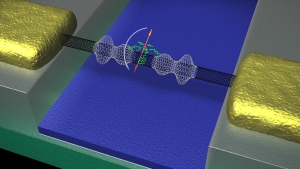Carbon nanotubes and magnetic molecules are considered building blocks of future nanoelectronic systems. Their electric and mechanical properties play an important role. Researchers of Karlsruhe Institute of Technology and French colleagues from Grenoble and Strasbourg have now found a way to combine both components on the atomic level and to build a quantum mechanical system with novel properties. It is reported now in the print version of nature nanotechnology journal (DOI: 10.1038/nnano.2012.258).
In their experiment the researchers used a carbon nanotube that was mounted between two metal electrodes, spanned a distance of about 1 µm, and could vibrate mechanically. Then, they applied an organic molecule with a magnetic spin due to an incorporated metal atom. This spin was oriented in an external magnetic field.
“In this setup, we demonstrated that the vibrations of the tube are influenced directly when the spin flips parallel or antiparallel to the magnetic field,” explains Mario Ruben, head of the working group at KIT. When the spin changes, the resulting recoil is transferred to the carbon nanotube and the latter starts to vibrate. Vibration changes the atomic distances of the tube and, hence, its conductance that is used as a measure of motion.
The strong interaction between a magnetic spin and mechanical vibration opens up interesting applications apart from determining the states of motion of the carbon nanotube. It is proposed to determine the masses of individual molecules and to measure magnetic forces within the nano-regime. Use as a quantum bit in a quantum computer might also be feasible.
According to the supplementary information published in the same issue of nature nanotechnology such interactions are of high importance in the quantum world, i.e. in the range of discrete energies and tunnel effects, for the future use of nanoscopic effects in macroscopic applications. Combination of spin, vibration, and rotation on the nanoscale in particular may result in entirely new applications and technologies.
Videoanimation shows wave on Carbon nanotube.
The online version of the print paper:
http://www.nature.com/nnano/journal/v8/n3/full/nnano.2012.258.html
The supplementary information:
http://www.nature.com/nnano/journal/v8/n3/pdf/nnano.2013.27.pdf
The homepage of the research group at KIT can be found at:
http://www.ruben-group.de/
Being “The University in the Helmholtz Association”, KIT creates and imparts knowledge for the society and the environment. It is the objective to make significant contributions to the global challenges in the fields of energy, mobility, and information. For this, about 10,000 employees cooperate in a broad range of disciplines in natural sciences, engineering sciences, economics, and the humanities and social sciences. KIT prepares its 22,800 students for responsible tasks in society, industry, and science by offering research-based study programs. Innovation efforts at KIT build a bridge between important scientific findings and their application for the benefit of society, economic prosperity, and the preservation of our natural basis of life. KIT is one of the German universities of excellence.

